
Olearia axillaris, commonly known as coastal daisy-bush, coast daisy-bush or coastal daisybush is a species of flowering plant in the family Asteraceae and is endemic to coastal areas of Australia. It is an erect, bushy shrub with densely cottony-hairy branchlets, aromatic, linear to narrowly elliptic or narrowly lance-shaped to egg-shaped leaves with the narrower end towards the base and small white and yellow, daisy-like inflorescences.

Olearia pimeleoides, commonly known as pimelea daisy-bush, is a species of flowering plant in the family Asteraceae and is endemic to southern continental Australia. It is an erect shrub with elliptic, linear or lance-shaped leaves, and white and pale yellow, daisy-like inflorescences.
Minuria is a genus of annuals, perennials and dwarf shrubs in the tribe Astereae within the familyAsteraceae.

Pomaderris intermedia, commonly known as lemon dogwood, is a species of flowering plant in the family Rhamnaceae and is endemic to south-eastern Australia. It is a shrub with hairy stems, elliptic to egg-shaped leaves, and clusters of yellow flowers.

Actinotus minor, commonly known as the lesser flannel flower, is species of flowering plant in the family Apiaceae and is endemic to New South Wales. It is a small, sprawling plant with grey-green leaves and white flowers.
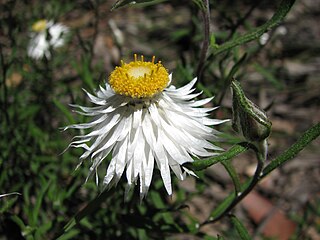
Helichrysum leucopsideum, commonly known as satin everlasting, is a flowering, perennial herb in the family Asteraceae. It is grows in all states of Australia except Queensland and the Northern Territory. It has white, terminal flower heads and narrow, woolly leaves.
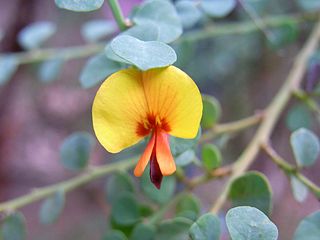
Bossiaea rhombifolia, is a species of flowering plant in the family Fabaceae and is endemic to eastern Australia. It is an erect, glabrous shrub with diamond-shaped, more or less round or broadly egg-shaped leaves, and yellow and red or pinkish flowers.
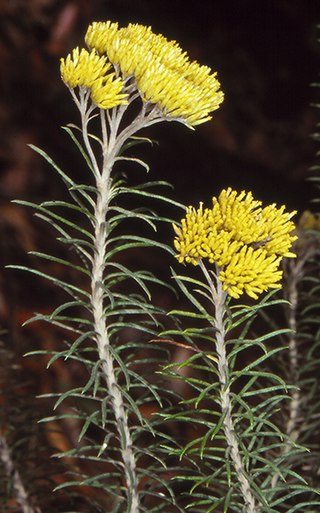
Cassinia cunninghamii, commonly known as Cunninghams everlasting, is a plant native to central New South Wales in eastern Australia.
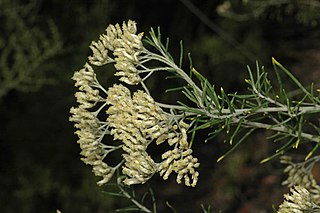
Cassinia uncata, commonly known as sticky cassinia, is a species of flowering plant in the family Asteraceae and is native to inland New South Wales and the south-east of South Australia. It is an erect shrub with hairy young stems, narrow linear to needle-shaped leaves, and heads of off-white to cream-coloured flowers arranged in rounded, almost conical panicles.

Olearia decurrens, commonly known as the clammy daisy bush, is a species of flowering plant in the family Asteraceae and is endemic to arid, inland Australia. It is a glabrous, sticky, twiggy shrub with narrow egg-shaped to linear leaves sometimes with toothed edges, and white and yellow, daisy-like inflorescences.

Tremandra is a genus of flowering plants in the family Elaeocarpaceae. It contains two species, both endemic to Western Australia.
Tremandra diffusa is a species of flowering plant in the family Elaeocarpaceae. It is a small shrub with white flowers and green oval shaped leaves.
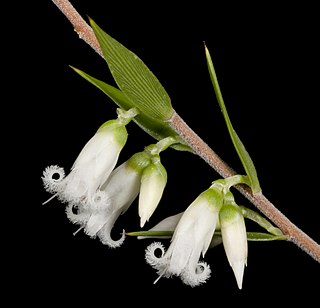
Styphelia conostephioides is a flowering plant in the family Ericaceae and is endemic to the south-west of Western Australia. It is an erect, straggling shrub with lance-shaped leaves with a sharp point on the tip, and white flowers arranged in pairs in leaf axils.
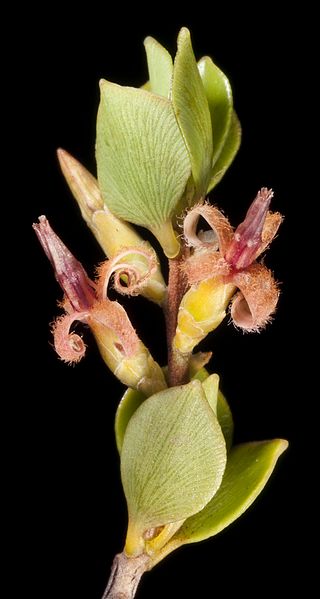
Styphelia coelophylla is a plant in the family Ericaceae endemic to the south west of Western Australia. It is an erect, bushy shrub with egg-shaped to lance-shaped leaves and tube-shaped flowers.

Pultenaea echinula, commonly known as curved bush-pea, is a species of flowering plant in the family Fabaceae and is endemic to a small area of New South Wales. It is an erect shrub with linear, needle-shaped, grooved leaves, and dense clusters of yellow to orange and red flowers.

Bossiaea lenticularis is a species of flowering plant in the family Fabaceae and is endemic to eastern New South Wales. It is a slender, spreading shrub with mostly circular leaves, and yellow and red flowers.

Leucopogon capitellatus is a species of flowering plant in the heath family Ericaceae and is endemic to the south-west of Western Australia. It is an erect, more or less glabrous shrub that typically grows to a height of 0.2–1 m. It has linear to lance-shaped leaves longer than about 12 mm (0.47 in) long, tapering to a rigid point on the tip. The flowers are borne on short spikes on the ends of branches or in leaf axils on short side branches, with small bracts and bracteoles about half as long as the sepals. The sepals are broad, about 2 mm (0.079 in) long and the petals white and about 4 mm (0.16 in) long, the petal lobes longer than the petal tube.

Olearia ramosissima, commonly known as much-branched daisy bush, is a species of flowering plant in the family Asteraceae and is endemic to continental Australia. It is a straggly shrub with densely-crowded, elliptic, egg-shaped or triangular leaves, and blue to violet and blue or yellow, daisy-like inflorescences.
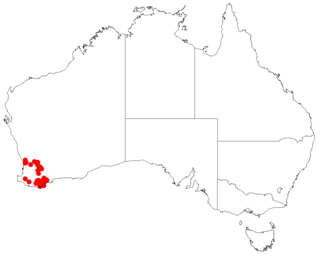
Styphelia cymbiformis is a flowering plant in the family Ericaceae and is endemic to the south-west of Western Australia. It is a bushy or wiry shrub that typically grows to a height of 30–50 cm (12–20 in) and has more or less glabrous branches. Its leaves are erect, linear to lance-shaped and sharply-pointed, mostly 2–4 mm (0.079–0.157 in) long. The flowers are arranged in short spikes, sometimes of only two or three flowers, with lance-shaped, leaf-like bracts, and bracteoles half as long as the sepals at the base of the spikes. The sepals are 2.5–3.0 mm (0.098–0.118 in) long and the petals slightly longer than the sepals, the lobes shorter than the petal tube.

Billardiera variifolia is a species of flowering plant in the family Pittosporaceae and is endemic to the southwest of Western Australia. It is a twining shrub or climber with elliptic adult leaves and groups of deep purple flowers that fade to blue as they age.



















